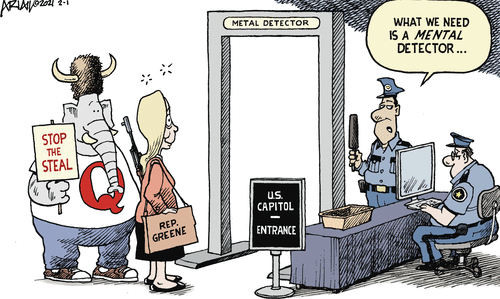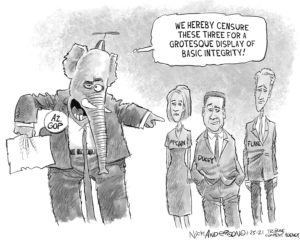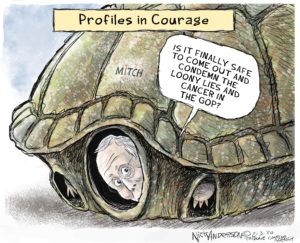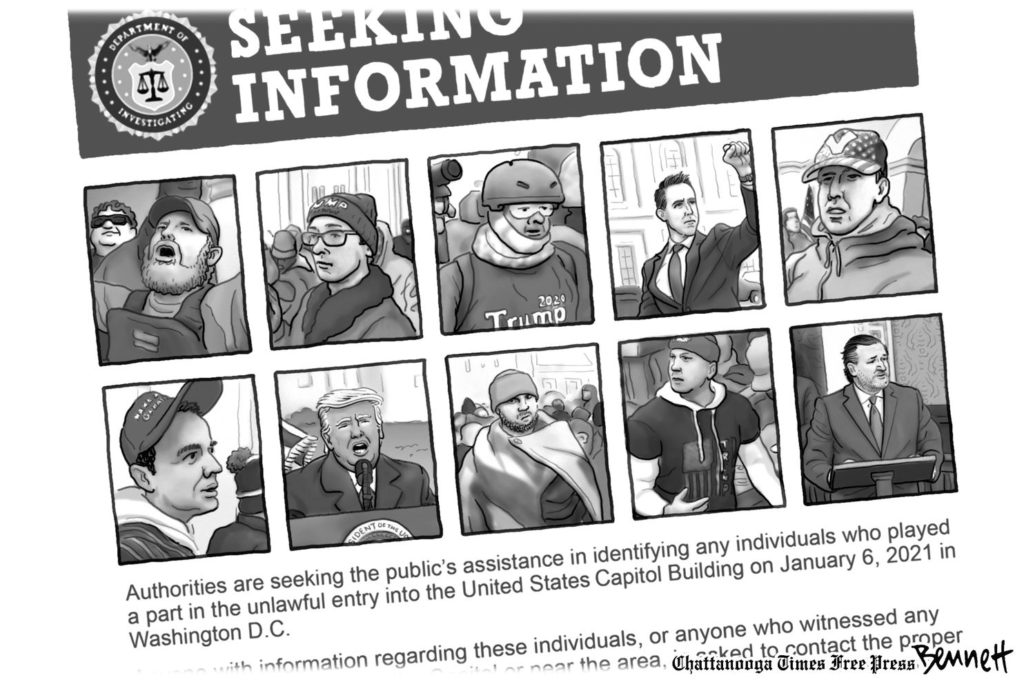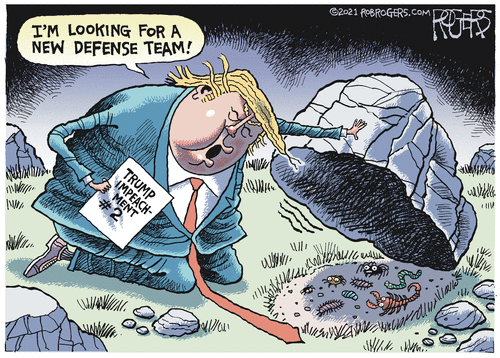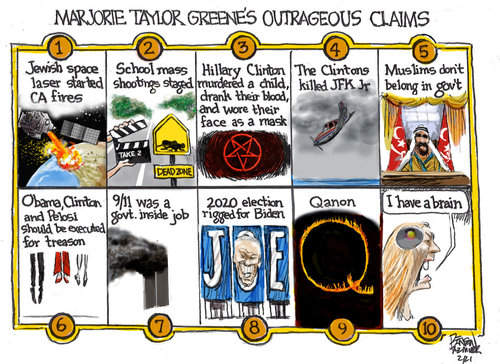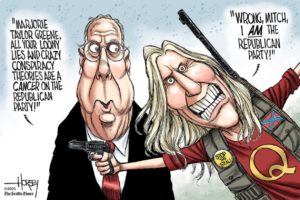Written by Elizabeth Moon.
The sequence given here is taken from the Vanity Fair article mentioned in the first post.
On the evening of January 5 the acting secretary of defense, Christopher Miller, was at the White House with his chief of staff, Kash Patel. The president asked how many troops the Pentagon planned to turn out the following day. Miller answered that he was ready to provide any National Guard support that the District requested. Trump then said he would need 10,000. The reporter (talking to Miller later) asked why Trump called for so many troops. Miller said that the anticipated crowd size (by those granting permits to gather at different areas of the Mall) were “all over the map, 5000 to 40,000.” (Later evidence was that different groups within the overall planning for the attack contacted the Park Police separately for permissions, citing different numbers.) Miller assumed the president, known for being grandiose, was just boosting the numbers.
It’s not credible that the Secretary of Defense would not have known long before this the probable size of the demonstration, since he could have information from multiple agencies and put together an estimate (on the basis of military planning) what a worse-case scenario would be. How many people would it take to overwhelm the unreinforced Capitol Police, get into the Capitol and the Congressional office buildings? How big are the civilian mobs US troops have faced before? A number of civilians, including me, had also looked at the security forces expected to be deployed ahead of time, based on the already known permits for gatherings.
Miller told the President, that someone would have to ask for the troops (authorize them). Normally that would be the President, since the District of Columbia National Guard is under the President’s direct command. Trump did not give that direct an order, but instead said “You do what you need to do,” and repeated “You’re going to need 10,000.”
The DC National Guard has 3400 members on the list, but spread across 14 different units, including a military band, a military police battalion, a transportation company, two aviation security and support groups for air ambulances, and more. In other words, it does not have 3400 troops trained for domestic security and riot control. It does have a small (about 340) detachment trained for rapid emergency response (when they are in their riot gear and armed.) In this instance the civilian government had asked them to be available to manage traffic. If the President was right that 10,000 would be needed, the actual turnout of the DC National Guard was woefully short of that. Normal procedure, when I was stationed at HQMC, was for National Guard troops to be on alert and moved in early in a disturbance-likely situation. If Miller had even the slightest concern that more troops might be needed, he would normally authorize the Secretary of the Army to contact the Governor of Maryland to alert the Maryland National Guard. Someone did that, because the Governor had activated his National Guard, and complained to the press about his difficulty getting clearance to act from the Secretary of the Army. Who? If the governor was aware of the need, why wasn’t Miller?
Allegedly, one sticking point was the District’s mayor, who had been furious and vocal about the excessive force used by Trump’s mix of federal troops (in unidentifiable uniforms) on July 1, against a non-violent crowd protesting in front of the White House, when the President decided to walk through Lafayette Square for a photo-op in front of a church he never attended.The mayor had sent a memo making it clear that the city was not requesting federal troops on January 6 except for traffic control, and asking to be informed (and her police chief to be informed) before troops were deployed.
There’s no indication that anyone contacted her to warn her about the extremely dangerous groups gathering, and that additional troops would almost certainly be needed to protect federal property and member of Congress. Moreover, when her office asked for assistance directly, it did not come for hours. She then reached out to the Governor of Maryland, who was stymied by National Guard command structure at the Pentagon. Her concern was, properly, the citizens of Washington, D.C.; failure to communicate with her is culpable.
One possibility is Miller’s Chief of Staff, “Kash” Patel, who formerly worked for Devin Nunes.In the Vanity Fair article, Patel comes across as a brash, smug individual.He told the reporter that Miller’s team was “on autopilot” most of the day, because they had no need for further discussion with the President:“We had talked to [the president] in person the day before, on the phone the day before, and two days before that. We were given clear instructions. We had all our authorizations. We didn’t need to talk to the president.” Patel says he was talking to Trump’s chief of staff, Mark] Meadows, nonstop, on January 6.
This is not the same story others have told about communications that day. By Miller’s account, he had not received a direct order to respond immediately to requests for help with any given force. “Do what you need to do,” could be any number of things depending on previous unwritten, unknown statements, including “Delay as long as you can without making it obvious.” The reporter of the article did not ask “What were those clear instructions?” or did not get an answer.
According to Miller, the Pentagon’s day began with a lull. “We had meetings upon meetings. We were monitoring it. And we’re just like, Please, God, please, God. Then the damn TV pops up and everybody converges on my office: [Joint Chiefs of Staff] chairman [Mark Milley], Secretary of the Army [Ryan McCarthy, the crew just converges.”
HOW were they “monitoring it?” Did they have eyes on the crowd at the President’s 7 am speech on the Ellipse? Did they have personnel embedded in the crowd? Listening to the chatter in the crowd, watching who carried what? Did they have personnel watching the newsfeeds? WHAT triggered the “everybody converges?” Good practice would have been to have direct monitoring of the President’s speech from 7 am, monitoring of the situation around the Capitol from daylight on if not also overnight, watching for intrusion, gatherings, weapons, etc., with personnel on the ground reporting directly to the Secretary of Defense. If that happened, Miller did not share it with the reporter afterwards.
From then on, the situation changed from watch and see to “a current op.” Miller said they had already decided they would need to activate the National Guard, “and that’s where the fog and friction comes in.”
At exactly what point did they consider it “a current op” and what readiness had gone before that point. What was the timeline expected from “it’s a current op” to troops on site? In a normal situation–let’s say the Women’s March in 2017–what was the lead time from activating the Guard to its arrival? Since that was NOT a violent attack on the Capitol, when was the massive security force present alerted, transported, and put in place?
What did Miller think of the criticism that the Pentagon had dragged its feet in sending in the cavalry? He bristled. “Oh, that is complete horseshit. I gotta tell you, I cannot wait to go to the Hill and have those conversations with senators and representatives.”
Personally I would love to confront Miller about this statement and ask the questions this reporter did not ask. What actual planning had Miller done before Jan 6? Had he conferred at all with DC or Capitol police? If so, what did he tell them? Did he have the DCNG on standby? If not, why not? How long did it normally take to “activate” the NG and get them to the Capitol and Mall? They’re less than two miles away at the DCNG Armory. Did he contact the Governor of Maryland? If so when? Who alerted the Governor and asked for assistance? (DC police? Capitol police? DC Mayor?) Why were both the Secretary of Defense and the Secretary of the Army unavailable to Maryland’s governor, who called repeatedly, as did the commander of the Maryland National Guard?
Miller insisted in the Vanity Fair article that he “knows” when something doesn’t smell right, when his people are playing CYA. “I know for an absolute fact that historians are going to look…at the actions that we did on that day and go, ‘Those people had their game together.’”
But which game? This is bullshit. I also know when something doesn’t smell right, and when commanders are CYA from helmet to boots, and this stinks like a truckload of fish in a ditch for a week. I know for an absolute fact that all but rabid right-wing historians are going to look at what happened–esp. historians with some military experience, and say “Worst case of bad choices, incompetence, and probable collusion with the enemy EVER.”
Miller and Patel both insisted, in separate conversations, that they neither tried nor needed to contact the president on January 6; they had already gotten approval to deploy forces. However, another senior defense official remembered things quite differently, “They couldn’t get through. They tried to call him”—meaning the president. The implication: Either Trump was shell-shocked, effectively abdicating his role as commander in chief, or he was deliberately stiff-arming some of his top officials because he was, in effect, siding with the insurrectionists and their cause of denying Biden’s victory.
And if that official is right that Miller, Patel, or Cohen (Miller’s two staffers)tried to call the president and couldn’t get through, that’s proof they lied about it.That bit is still unknown.
Miller stated that he did speak with Pence—then in a secure location on the Hill—and provided a situation report. Referring to the Electoral College certification that had been paused when the mob stormed the building, Miller recalled Pence saying, “We got to get this thing going again,” to which the defense secretary replied, “Roger. We’re moving.”
At what time did Miller contact Pence (or vice versa?) How secure was that location? Remember the “turn on the gas and lock ’em in?” comment by one of the bad guys? And what precisely did “We’re moving” mean?
Patel, for his part, said that those assembled in Miller’s office also spoke with congressional leaders Nancy Pelosi, Chuck Schumer, and Mitch McConnell.Patel said, “We were called upon to do our job, and we executed because we had the reps and sets built into our process to get the troops where they were requested, to put up a fence, to secure a perimeter, and to help clear the Capitol compound. I mean, that’s just what we do.”
That’s bragging.Did the Congressional leaders call them, or did they call the Congressional leaders?What did those leaders say? When was that call exactly?They “executed” WHEN?What was the situation when the National Guard troops (DC’s and Maryland’s, each) arrived in the area?How long from a conversation with them, to the arrival of NG troops on the Hill?What are “reps and sets” in this instance?Were the National Guard troops they would use on site at the Armory, and if not, where were they?Was Miller in contact with the District municipal police force or the Capitol police to get permission to arm the NG?(He later had no problem calling out and arming the NG, including Maryland, remotely from TN prior to the Inauguration.)
Cohen was promoted to a more senior role and Patel brought into the Pentagon in the wake of Miller’s appointment, adding to the view that they were Trump watchmen implanted to keep a keen eye on things. Both had drawn scads of media attention—Patel, in particular, for trying to help discredit Robert Mueller’s Russia investigation and for his appearance in the Ukraine controversy that led to Trump’s first impeachment. People across the national security spectrum said: You don’t have to like, respect, or agree with Cohen and Patel, but you underestimate their drive and Machiavellian prowess at your own peril.
Both these men had worked for and with Devin Nunes in the past and were, like Nunis, solid Trumpists.

